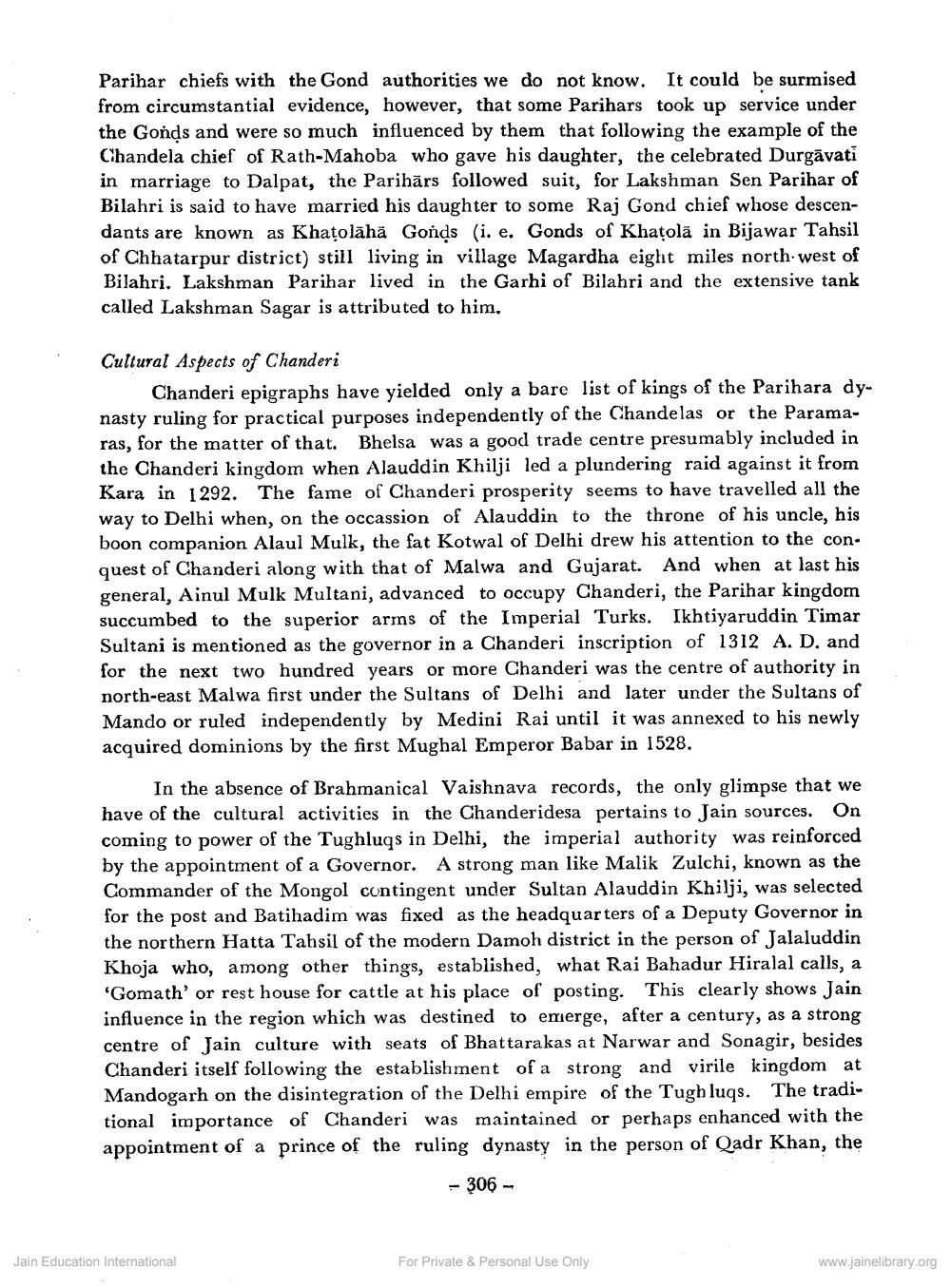Book Title: Chanderi Under Malva Sultansa Author(s): H A Nijamji Publisher: Z_Kailashchandra_Shastri_Abhinandan_Granth_012048.pdf View full book textPage 3
________________ Parihar chiefs with the Gond authorities we do not know. It could be surmised from circumstantial evidence, however, that some Parihars took up service under the Gonds and were so much influenced by them that following the example of the Chandela chief of Rath-Mahoba who gave his daughter, the celebrated Durgavati in marriage to Dalpat, the Parihärs followed suit, for Lakshman Sen Parihar of Bilahri is said to have married his daughter to some Raj Gond chief whose descendants are known as Khatolāhā Gonds (i. e. Gonds of Khatolā in Bijawar Tahsil of Chhatarpur district) still living in village Magardha eight miles north west of Bilahri. Lakshman Parihar lived in the Garhi of Bilahri and the extensive tank called Lakshman Sagar is attributed to him. Cultural Aspects of Chanderi Chanderi epigraphs have yielded only a bare list of kings of the Parihara dynasty ruling for practical purposes independently of the Chandelas or the Paramaras, for the matter of that. Bhelsa was a good trade centre presumably included in the Chanderi kingdom when Alauddin Khilji led a plundering raid against it from Kara in 1292. The fame of Chanderi prosperity seems to have travelled all the way to Delhi when, on the occassion of Alauddin to the throne of his uncle, his boon companion Alaul Mulk, the fat Kotwal of Delhi drew his attention to the conquest of Chanderi along with that of Malwa and Gujarat. And when at last his general, Ainul Mulk Multani, advanced to occupy Chanderi, the Parihar kingdom succumbed to the superior arms of the Imperial Turks. Ikhtiyaruddin Timar Sultani is mentioned as the governor in a Chanderi inscription of 1312 A. D. and for the next two hundred years or more Chanderi was the centre of authority in north-east Malwa first under the Sultans of Delhi and later under the Sultans of Mando or ruled independently by Medini Rai until it was annexed to his newly acquired dominions by the first Mughal Emperor Babar in 1528. In the absence of Brahmanical Vaishnava records, the only glimpse that we have of the cultural activities in the Chanderidesa pertains to Jain sources. On coming to power of the Tughluqs in Delhi, the imperial authority was reinforced by the appointment of a Governor. A strong man like Malik Zulchi, known as the Commander of the Mongol contingent under Sultan Alauddin Khilji, was selected for the post and Batihadim was fixed as the headquarters of a Deputy Governor in the northern Hatta Tahsil of the modern Damoh district in the person of Jalaluddin Khoja who, among other things, established, what Rai Bahadur Hiralal calls, a 'Gomath' or rest house for cattle at his place of posting. This clearly shows Jain influence in the region which was destined to emerge, after a century, as a strong centre of Jain culture with seats of Bhattarakas at Narwar and Sonagir, besides Chanderi itself following the establishment of a strong and virile kingdom at Mandogarh on the disintegration of the Delhi empire of the Tugh luqs. The traditional importance of Chanderi was maintained or perhaps enhanced with the appointment of a prince of the ruling dynasty in the person of Qadr Khan, the - 306 - Jain Education International For Private & Personal Use Only www.jainelibrary.orgPage Navigation
1 2 3 4 5 6 7 8
